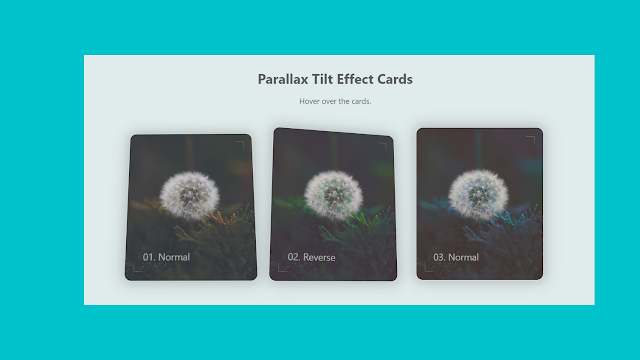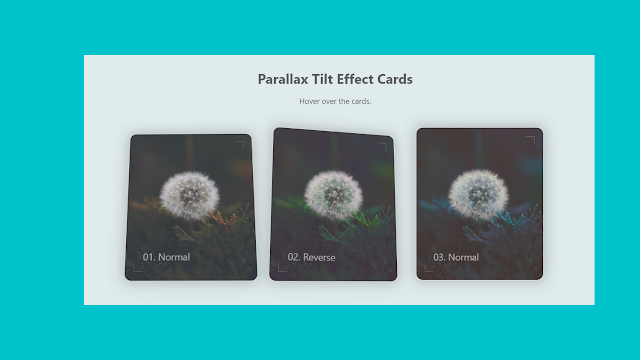Parallax Tilt Card Effect Using HTML and CSS
Welcome to the Codewithrandom blog. In this blog, we learn how to create a Parallax Tilt Card Effect. We use Html, Css, and JavaScript for this Parallax Tilt Card Effect.
I hope you enjoy our blog so let’s start with a basic Html Structure for a Parallax Tilt Card Effect.
HTML Code For Parallax Tilt Card Effect
<h1>Parallax Tilt Effect Cards</h1> <p>Hover over the cards.</p> <section class="main"> <div class="wrap wrap--1"> <div class="container container--1"> <p>01. Normal</p> </div> </div> <div class="wrap wrap--2"> <div class="container container--2"> <p>02. Reverse</p> </div> </div> <div class="wrap wrap--3"> <div class="container container--3"> <p>03. Normal</p> </div> </div> </section>
There is all the Html code for the Parallax Tilt Card Effect. Now, you can see output without Css and JavaScript. then we write Css for styling the Card and give the Tilt Effect Using JavaScript.
Weather App Using Html,Css And JavaScript
Only Html Code Output
CSS Code For Parallax Tilt Card Effect
*,
*::after,
*::before {
margin: 0;
padding: 0;
box-sizing: border-box;
}
html {
font-size: 62.5%;
}
body {
--background-color: hsl(180, 20%, 90%);
font-family: -apple-system, BlinkMacSystemFont, 'Segoe UI', Roboto, Oxygen, Ubuntu, Cantarell, 'Open Sans', 'Helvetica Neue', sans-serif;
min-height: 100vh;
padding: 2rem;
color: hsla(0, 0%, 0%, .6);
background: var(--background-color);
text-align: center;
}
h1 {
font-size: 3.2rem;
padding-top: 2rem;
}
h1+p {
font-size: 1.8rem;
padding: 2rem 0 3rem;
}
.main {
display: flex;
flex-wrap: wrap;
justify-content: center;
align-items: center;
}
.wrap {
margin: 2rem;
transform-style: preserve-3d;
transform: perspective(100rem);
cursor: pointer;
}
.container {
--rX: 0;
--rY: 0;
--bX: 50%;
--bY: 80%;
width: 30rem;
height: 36rem;
border: 1px solid var(--background-color);
border-radius: 1.6rem;
padding: 4rem;
display: flex;
align-items: flex-end;
position: relative;
transform: rotateX(calc(var(--rX) * 1deg)) rotateY(calc(var(--rY) * 1deg));
background: linear-gradient(hsla(0, 0%, 100%, .1), hsla(0, 0%, 100%, .1)), url("https://images.unsplash.com/photo-1559113513-d5e09c78b9dd?ixlib=rb-1.2.1&q=80&fm=jpg&crop=entropy&cs=tinysrgb&w=1080&fit=max&ixid=eyJhcHBfaWQiOjF9");
background-position: var(--bX) var(--bY);
background-size: 40rem auto;
box-shadow: 0 0 3rem .5rem hsla(0, 0%, 0%, .2);
transition: transform .6s 1s;
}
.container::before,
.container::after {
content: "";
width: 2rem;
height: 2rem;
border: 1px solid #fff;
position: absolute;
z-index: 2;
opacity: .3;
transition: .3s;
}
.container::before {
top: 2rem;
right: 2rem;
border-bottom-width: 0;
border-left-width: 0;
}
.container::after {
bottom: 2rem;
left: 2rem;
border-top-width: 0;
border-right-width: 0;
}
.container--active {
transition: none;
}
.container--2 {
filter: hue-rotate(80deg) saturate(140%);
}
.container--3 {
filter: hue-rotate(160deg) saturate(140%);
}
.container p {
color: hsla(0, 0%, 100%, .6);
font-size: 2.2rem;
}
.wrap:hover .container::before,
.wrap:hover .container::after {
width: calc(100% - 4rem);
height: calc(100% - 4rem);
}
.abs-site-link {
position: fixed;
bottom: 20px;
left: 20px;
color: hsla(0, 0%, 0%, .6);
font-size: 1.6rem;
}Here is our updated output Of Parallax Tilt Card Effect HTML + CSS.
50+ Html ,Css & Javascript Projects With Source Code
CSS Output
JavaScript Code For Parallax Tilt Card Effect
class parallaxTiltEffect {
constructor({element, tiltEffect}) {
this.element = element;
this.container = this.element.querySelector(".container");
this.size = [300, 360];
[this.w, this.h] = this.size;
this.tiltEffect = tiltEffect;
this.mouseOnComponent = false;
this.handleMouseMove = this.handleMouseMove.bind(this);
this.handleMouseEnter = this.handleMouseEnter.bind(this);
this.handleMouseLeave = this.handleMouseLeave.bind(this);
this.defaultStates = this.defaultStates.bind(this);
this.setProperty = this.setProperty.bind(this);
this.init = this.init.bind(this);
this.init();
}
handleMouseMove(event) {
const {offsetX, offsetY} = event;
let X;
let Y;
if (this.tiltEffect === "reverse") {
X = ((offsetX - (this.w/2)) / 3) / 3;
Y = (-(offsetY - (this.h/2)) / 3) / 3;
}
else if (this.tiltEffect === "normal") {
X = (-(offsetX - (this.w/2)) / 3) / 3;
Y = ((offsetY - (this.h/2)) / 3) / 3;
}
this.setProperty('--rY', X.toFixed(2));
this.setProperty('--rX', Y.toFixed(2));
this.setProperty('--bY', (80 - (X/4).toFixed(2)) + '%');
this.setProperty('--bX', (50 - (Y/4).toFixed(2)) + '%');
}
handleMouseEnter() {
this.mouseOnComponent = true;
this.container.classList.add("container--active");
}
handleMouseLeave() {
this.mouseOnComponent = false;
this.defaultStates();
}
defaultStates() {
this.container.classList.remove("container--active");
this.setProperty('--rY', 0);
this.setProperty('--rX', 0);
this.setProperty('--bY', '80%');
this.setProperty('--bX', '50%');
}
setProperty(p, v) {
return this.container.style.setProperty(p, v);
}
init() {
this.element.addEventListener('mousemove', this.handleMouseMove);
this.element.addEventListener('mouseenter', this.handleMouseEnter);
this.element.addEventListener('mouseleave', this.handleMouseLeave);
}
}
const $ = e => document.querySelector(e);
const wrap1 = new parallaxTiltEffect({
element: $('.wrap--1'),
tiltEffect: 'reverse'
});
const wrap2 = new parallaxTiltEffect({
element: $('.wrap--2'),
tiltEffect: 'normal'
});
const wrap3 = new parallaxTiltEffect({
element: $('.wrap--3'),
tiltEffect: 'reverse'
});Final Output Of Parallax Tilt Card Effect Using HTML,CSS and JavaScript
Now we have completed our Parallax Tilt Card Effect. Here is our updated output with Html, Css, and JavaScript. Hope you like the Parallax Tilt Card Effect Project. you can see the output video and project screenshots. See our other blogs and gain knowledge in front-end development.
Thank you!
In this post, we learned how to create a Parallax Tilt Card Effect Using Html, Css, and JavaScript. If we made a mistake or any confusion, please drop a comment to reply or help you in easy learning.
Written by – Code With Random/Anki
Code by – Abubaker Saeed









Loved it������